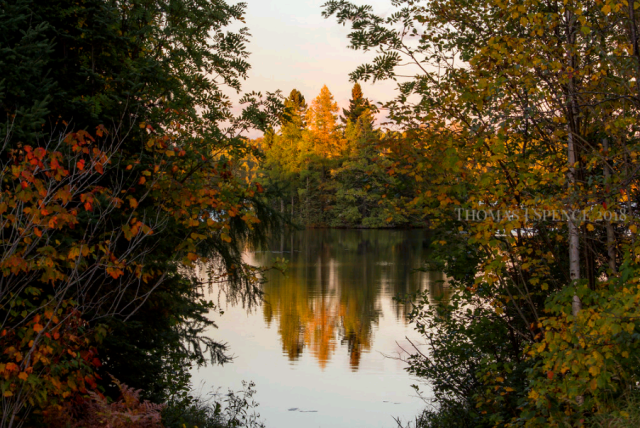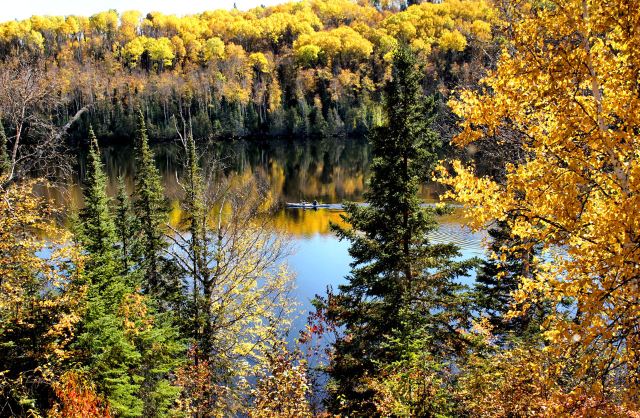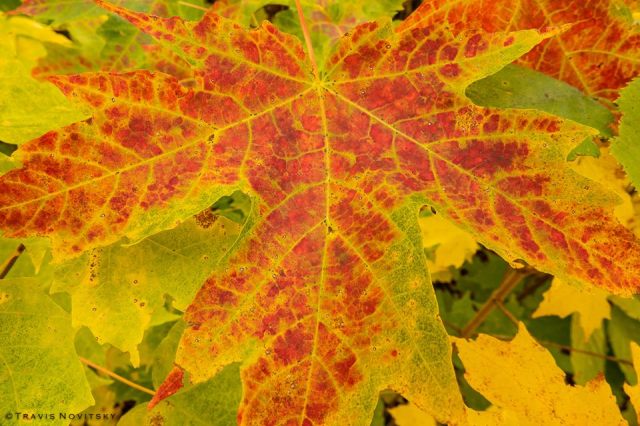
We all carry with us a mental image of what a gorgeous fall photograph should feature: vivid orange and red trees, clear blue skies, hiking paths blanketed in colorful leaves. Fall is the photographer’s dream-come-true season, because of the brilliant changing of the colors. But there’s much more to autumn photography on the North Shore and the Gunflint Trail than just leaves.
Often the most remarkable pictures of fall are taken in the weeks after the leaf color has peaked, when the leaves start to fall, making every plant, animal, and natural feature within the woods much more visible. Mushrooms in a variety of wild shapes and colors pop up everywhere in the woods. The tamaracks, a tree relatively few people seem to even recognize, begin turning vivid colors in October. And of course, wildlife starts to wander in the later days of fall.
Moose become more visible. October can be almost as good for moose viewing as the spring days are, although because the moose are in rut, a bit more caution is required. Moose pictures from the fall are usually more dramatic, because their coats have turned dark and glossy, their antlers have matured, and the moose are generally in peak condition. Wolves and foxes are also often spotted in the woods during fall, usually with thick glossy coats from a summer of successful hunting.
We asked some of the North Shore’s favorite photographers to share their ideas for what to photograph in the fall. Of course, they all photograph the changing leaves, but anyone with a phone camera and few days off can go home from a trip up north with a few nice leaf pictures. Follow these photographers’ suggestions to return from your Bearskin trip with fall pictures that really “pop.”

Travis is a lifelong resident of the North Shore who is best known for his night sky photography. He was one of the presenters at the BWCA Expo in June, 2018, and you may have seen him featured on KARE 11 in August, 2018.
Travis told us, “Fall is one of my favorite times of the year for photography. The changing leaf colors are obviously a main highlight, and for that my favorite thing to do is get to an elevated viewpoint such as a hilltop overlook or a fire tower. Getting above the trees lets you take in a lot more of the broad expanse of color. Also, on cool mornings there is often fog in the valleys. As the fog burns off you can get photos of the trees and leaf colors combined with the fog. This makes for some pretty surreal images.”
Our guests are always hoping for a clear day with blue skies for their fall photography journeys, but in a fall when we’ve had an unusually high number of overcast days, Travis doesn’t mind. “If you’re going to be on the ground beneath the forest canopy, I much prefer cloudy days for photographing fall color. The light is flatter and the colors appear much more vibrant, especially if you switch your camera’s white balance setting to cloudy or shade. On sunny days there is generally too much contrast between bright light and dark shadows to make good photographs when you are beneath the forest canopy. If you’re out in the open, however, and photographing a single tree or group of trees with good color, nothing complements that color like a nice touch of blue sky. “
“Fall is also a great time for macro-photography,” he says, “especially after about half of the leaves have fallen to the ground. I love walking along a trail or forest road and looking at the ground for interesting leaf arrangements. If it’s a rainy day or if it rained overnight, the collections of water droplets on the leaves can make for a mesmerizing macro-photo.”
“Lastly, for those that are already familiar with my work, you know that I am really into night sky photography. Late fall is a great time for this. As the leaves drop from the trees the wonderful shapes and silhouettes of the trees are once again revealed to us. They make a great foreground for a night sky photo, looking up at the trees with the stars, moonlight or northern lights shining above. I am always on the lookout for trees with really unique shapes. When I find one I make a note to go back and photograph it with the night sky when the leaves have fallen.”
See Travis Novitsky’s latest pictures here or purchase his prints here.

Mark is living the dream. Not too long ago, he was a regular Bearskin guest. When he and his wife moved to Grand Marais, Mark began to take his photography skills much more seriously. If you’ve ever imagined you could move to the northwoods and become a photographer, Mark is proof that it can be done.
Mark points out, “I’m lucky to live in a place that has spectacular scenery anytime, but fall has some especially great opportunities. Everyone likes to find those high sweeping vistas, but they can be tricky to pull off. Using a wide angle lens can make things seem awfully small, and doesn’t match the image you envision. Sometimes a single tree, or even a couple brilliantly colored leaves can really create a fall feel. Using a telephoto to zoom into a particular composition can tell a great fall story.”
Like Travis, Mark is a fan of overcast days. “While everyone loves a bright blue sky to contrast those reds and yellows, sunny days can be troublesome when taking photos. The bright sun casts lots of shadows that can obscure some of the scenery we are trying to capture. Our eyes can make the adjustment, but the camera doesn’t have the dynamic range to see into the shadows and also keep the bright areas from blowing out. Cloudy days soften the light and allow you to capture the scene more accurately. And don’t shy away from photographing in rain. The wet landscape can really saturate the colors and make them more vivid.” Good advice for this fall.
Mark has taken some especially spectacular water photographs recently. “I’m always looking for compositions to incorporate a pond, lake, or waterfall into my fall shots. You can get reflections off the water to create some great looking photos! I use a polarizing filter when I want to dial in that perfect level of reflection off the water.”
Like many of our favorite photographers, Mark gets out early with his camera and takes some especially beautiful sunrise pictures. “One other bonus of fall photography is that the sunrise is coming up over Lake Superior again, and that is one of my favorite subjects to photograph.”
You can follow Mark’s daily adventures with his camera at Mark Morgen Photography on Facebook.

We often share Tom Spence’s photographs to the Bearskin web page. He was also one of the contributors to our spring moose-viewing blog, offering great advice on how to find and photograph animals in the spring.
Tom believes the best photographs of moose are taken in autumn. “In late summer, the bull moose lose their velvet on their racks and the antlers become a bright, shiny color. The moose can be pretty active in fall, giving me more opportunities.”
He recommends heading into the woods with a camera after peak color season is over. “With the leaves falling and gone, October and November can reveal parts of the woods that are harder to see through and into than the spring and summer months, increasing the area I can search.”
Like Mark, Tom gets some fabulous water pictures and recommends our North Shore state parks as a great resource in the fall. “The rivers are my favorite. I like to use a circular polarizing filter and a neutral density filter for fall waterfall photography allowing for the long exposure, dreamy effect on the water.”
Tom is a camper, and his lit-up tent often appears as a centerpiece in pictures. “I tend to do more camping in the fall, so BWCA photography is also a favorite. I love the solitude and quiet of October in the Boundary Waters. The nights tend to get longer, so the aurora borealis may be seen a bit more often as well. A few of my favorite aurora displays have been in the fall months.”
You can check out more of Tom’s pictures on his Facebook page , at his photography blog and photo site Thomas J. Spence Images, or browse and buy photos you like on Tom’s SmugMug website.
Nace Hagemann

Nace is well known for his Gunflint Trail moose photos, but because he is often out early in the morning, and because he travels around Cook County so much for his work, he has success photographing many other animals, also. Nace was also a contributor to our spring moose-viewing blog.
Nace looks at photography in the fall just about the same as in any other season. “For the wildlife that I am primarily looking for,” he says, “I try to get to places with no one else around.” He tries to hit the likely spots at a time when other people are less likely to be there. “Or it can mean hiking in a little farther, or paddling to a lake that isn’t visited often. ” This is one reason fall photography in our area can be more successful — there are far fewer people here in the fall. Nace adds, “I also try to be quiet to not spook animals if I do happen to see something.”
If you love the look of mist over the water, fall is the time to be here. Nace says, “One of my favorite things about fall is fog. As the air starts to cool faster than the lakes, you can often find fog over water on a crisp morning. If I could, I would spend most fall mornings in a canoe photographing anything in fog. There is something magical about fog.”
Nace also has success capturing the northern lights. If you’ve seen the card with the northern lights behind the Bearskin Lodge sign, that is Nace’s work. “In the fall there are more hours of darkness so northern lights can be easier to see if they happen to be out that night.” It’s generally pleasant on fall nights, unlike trying to photograph the lights in January.
Nace’s pictures can be seen on his Facebook site and can also be purchased here.
Where to get a great fall photo at Bearskin Lodge.

Our front desk staff members are all avid outdoors people who know the area well. They are happy to help you find your perfect photo spot.
Talk to Katie, our moose photographer, about the latest moose sightings. We keep a map at the front desk where we can mark the places where moose have been recently observed. If your primary goal is to photograph moose, we encourage you to come up in a vehicle that does well on rough roads. One of the best roads for fall moose sightings is in dire condition this year (and yes, every year). You might spot a moose right off the Gunflint Trail, but a robust vehicle will get you deeper into moose country up here.
The Gunflint Trail has primarily moose maples instead of sugar maple trees, so your fall photos from this area will feature more yellow and orange leaves, rather than red hues. One of the most popular overlooks for photos any season is, of course, Honeymoon Bluff, just a few miles away from Bearskin. Caribou Rock has several great overlooks that photograph nicely in the fall. We can direct you to a high spot on Bear Cub where you can get the long view northward over the trees. The area of around the esker trail in the campground gets you long, color views of East Bearskin Lake in the autumn. If colorful tamarack bogs are you photographic goal, once the tamarcs have turned we can direct you to several nice locations that always offer stunning color contrast for photos.
Early morning is still the best time to photograph the trees, lakes, and wildlife along the North Shore and the Gunflint. But here’s a tip if you head out in the late afternoon or evening: always bring headlamps and flashlights with you. It gets dark earlier and faster in the fall, and your time between that last “sun setting on the fall colors” moment and total darkness is very short. Because our family and many Bearskin staff members are on Search & Rescue we hear rescue calls constantly in Sepetmeber – November for parties who didn’t get off Eagle Mountain, Oberg Mountain, the Cascade River walk, and Caribou Rock before dark. The Caribou Rock Trail has some great vistas that photograph well in fall, but you truly want to get off that trail before any hint of darkness arrives. Wherever you hike along the North Shore or the Gunflint this fall, plan for an earlier sunset than you are accustomed to having farther south. Immersed in the beauty of this area, it easy to forget that we are in one of America’s last “dark skies” area, so when the sun sets it gets seriously pitch black out in the woods.
Everyone at Bearskin will be happy to help you come back from your fall getaway to our area with some outstanding photographs to keep as memories. Give us a call at (800) 338-4170 or visit www.bearskin.com and let’s make a plan together.

